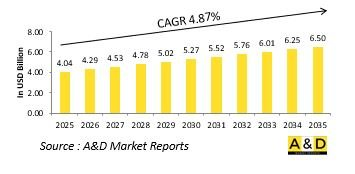
|
市場調査レポート
商品コード
1831813
ミサイル推進の世界市場:2025年~2035年Global Missile Propulsion Market 2025-2035 |
||||||
|
|||||||
| ミサイル推進の世界市場:2025年~2035年 |
|
出版日: 2025年10月06日
発行: Aviation & Defense Market Reports (A&D)
ページ情報: 英文 150+ Pages
納期: 3営業日
|
概要
世界のミサイル推進の市場規模は、2025年に40億4,000万米ドルと推定され、2035年には65億米ドルに成長すると予測されており、予測期間の2025年~2035年の年間平均成長率(CAGR)は4.87%と見込まれています。

世界のミサイル推進市場イントロダクション:
防衛ミサイル推進市場は世界の防衛産業の重要なセグメントであり、最新のミサイルシステムの性能、射程距離、有効性を支えています。推進技術は、ミサイルが速度、精度、信頼性をもって目標に到達することを可能にする原動力であり、戦略的抑止、戦術的作戦、国土安全保障にとって不可欠なものとなっています。脅威が進化し、各国が攻撃力と防御力の強化に注力する中、先進的な推進システムへの需要は高まり続けています。現代の軍隊は、短距離の戦術的交戦から長距離の戦略的任務まで、多様な範囲にわたって標的を攻撃できるミサイルを必要としており、推進力の革新に大きな重点を置いています。さらに、極超音速兵器、精密誘導弾、多領域作戦の台頭は、推進力の展望を再構築し、防衛請負業者や研究開発機関に、より軽量で効率的、かつ適応性の高い推進システムの開発を促しています。この市場の進化は、材料科学、燃料化学、空力設計の進歩、および推進技術と誘導制御システムとの統合の進展と密接に結びついています。その結果、ミサイル推進部門は依然として国家防衛戦略の要であり、国家の抑止力と攻撃能力の有効性と範囲に直接影響を及ぼしています。
ミサイル推進市場における技術の影響:
技術の進歩は、防衛ミサイル推進の状況を大きく変化させ、航続距離、操縦性、燃料効率、システム全体の性能の向上を促しています。固体、液体、ハイブリッド、空気呼吸推進システムの革新により、ミサイルの高速化、高精度化、競合環境における優れた生存性の実現が可能になりつつあります。スクラムジェットやラムジェットなどの新技術は極超音速飛行の限界を押し広げ、ミサイルが安定性と制御性を維持しながら極端な速度で飛行することを可能にしています。さらに、複合材料や軽量構造の進歩によって質量が減少し、燃料効率が向上しているため、ペイロードの重量を増加させることなく運用可能距離が延長されています。推進システムの小型化における開発も、高度なミサイル技術の小型プラットフォームへの統合を可能にし、より広範な戦術的・戦略的任務をサポートしています。さらに、人工知能と高度なモデリング技術の統合により、推進システムの設計、試験、性能予測が強化され、開発期間が大幅に短縮されています。このような技術的飛躍的進歩は、従来のミサイル能力を向上させるだけでなく、宇宙やサイバーに対応した戦争を含むマルチドメイン作戦用に設計された次世代システムの構築を促進しています。各国が最先端の推進力研究に投資する中、この技術の影響は現代の戦争力学を再定義し、将来の防衛戦略を形成しています。
ミサイル推進市場の主な促進要因:
防衛ミサイル推進市場の持続的な成長と革新の原動力となっている要因はいくつかあります。主な促進要因の1つは、高速交戦、精密照準、長距離攻撃要件を特徴とする現代戦争の進化した性質です。各国は、防衛システムが極超音速兵器、高度な防空、進化する弾道ミサイル能力などの新たな脅威に効果的に対抗できるようにするため、ミサイル推進技術に多額の投資を行っています。地政学的緊張と地域紛争は、各国が技術的優位性と戦略的抑止力を維持しようとするため、ミサイル性能の向上に対する需要をさらに加速させています。国防近代化プログラムと研究開発に対する政府支出の増加は、推進システムの技術革新に拍車をかけ、従来の推進ソリューションから先進的な高効率設計への移行を可能にしています。さらに、宇宙空間や宇宙近傍での用途を含む多領域作戦への注目の高まりが、多様な環境で運用できる汎用性の高い推進技術の開発を後押ししています。防衛機関、民間企業、研究機関の間の協力関係も重要な要因であり、科学的なブレークスルーを配備可能なミサイル・システムに迅速に変換することを促進しています。これらの競合要因が相まって、非常に競争が激しく、急速に進化する市場が形成されています。
ミサイル推進市場の地域動向:
防衛ミサイル推進力市場は、さまざまな地域でダイナミックな成長を遂げており、それぞれが独自の戦略的優先事項、安全保障上の懸念、産業能力によって形成されています。北米では、技術的優位性を維持し、強固なミサイル防衛アーキテクチャをサポートする必要性から、先進推進技術への投資が活発に行われています。欧州は、相互運用性と、進化する安全保障課題に対応するためのミサイルシステムの近代化を重視し、共同開発イニシアティブに注力しています。アジア太平洋は重要な成長センターとして台頭しており、固有のミサイル計画が急速に進展し、極超音速ミサイルや長距離攻撃能力への投資も活発化しています。地域的緊張の高まりと領土紛争が、抑止と迅速な対応戦略を支援できる高度な推進システムへの需要に拍車をかけています。中東では、地域が不安定で脅威情勢が変化する中、各国がミサイルによる抑止力を強化するために推進技術を優先しています。一方、新興経済国は、戦略的自律性を達成し、外国のサプライヤーへの依存を減らすために、自国の推進能力に投資しています。どの地域でも、より高い効率性、モジュール性、適応性を提供する推進システムに重点が移りつつあり、これは防衛戦略の幅広い進化と、現代の軍事作戦における精度、速度、到達距離の重要性の高まりを反映しています。
主要ミサイル推進プログラム:
L3Harris Technologiesは、ジャベリン・ウェポン・システムの推進システムを供給し続けるため、最大2億9,200万米ドル相当の契約を獲得しました。これはジャベリン・プログラム史上最大の推進剤製造契約であり、さらに5年間製造が延長されます。同社はジャベリンを含む複数のプログラムで固体ロケットモーターの生産を拡大しており、これは社内の製造投資と陸軍省との2億1,560万米ドルの協力協定に支えられています。これらの努力の一環として、L3Harrisはジャベリン・ラインに完全デジタル生産ワークフローを導入し、リアルタイムのデータ追跡、品質監視の強化、生産効率の管理改善を可能にしています。L3Harrisは、ジャベリン固体ロケットモーターの独占的生産者であり、ジャベリン兵器システム自体は、Lockheed MartinとRaytheonの共同開発であるJavelin Joint Ventureによって、米国陸軍、海兵隊、および海外の顧客向けに開発・生産されています。
目次
ミサイル推進市場の目次
ミサイル推進市場のレポートの定義
ミサイル推進市場セグメンテーション
エンジン別
地域別
タイプ別
今後10年間のミサイル推進市場分析
この章では、10年間のミサイル推進市場分析により、ミサイル推進市場の成長、変化する動向、技術採用の概要、および全体的な市場の魅力について詳細な概要が示されます。
ミサイル推進市場の市場技術
このセグメントでは、この市場に影響を与えると予想される上位10の技術と、これらの技術が市場全体に与える可能性のある影響について説明します。
世界のミサイル推進市場予測
この市場の10年間のミサイル推進市場予測は、上記のセグメントにわたって詳細に説明されています。
地域ミサイル推進市場の動向と予測
このセグメントでは、地域別のミサイル推進市場動向、促進要因、抑制要因、課題、そして政治、経済、社会、技術といった側面を網羅しています。また、地域別の市場予測とシナリオ分析も詳細に取り上げています。地域分析の最終段階では、主要企業のプロファイリング、サプライヤーの情勢、企業ベンチマークなどについて分析しています。現在の市場規模は、通常のシナリオに基づいて推定されています。
北米
促進要因、抑制要因、課題
PEST
市場予測とシナリオ分析
主要企業
サプライヤー階層の情勢
企業ベンチマーク
欧州
中東
アジア太平洋
南米
ミサイル推進市場の国別分析
この章では、この市場における主要な防衛プログラムを取り上げ、この市場で申請された最新のニュースや特許についても解説します。また、国レベルの10年間の市場予測とシナリオ分析についても解説します。
米国
防衛プログラム
最新ニュース
特許
この市場における現在の技術成熟度
市場予測とシナリオ分析
カナダ
イタリア
フランス
ドイツ
オランダ
ベルギー
スペイン
スウェーデン
ギリシャ
オーストラリア
南アフリカ
インド
中国
ロシア
韓国
日本
マレーシア
シンガポール
ブラジル
ミサイル推進市場の機会マトリックス
機会マトリックスは、読者がこの市場における機会の高いセグメントを理解するのに役立ちます。
ミサイル推進市場レポートに関する専門家の意見
この市場の可能性のある分析についての当社の専門家の意見をお届けします。


